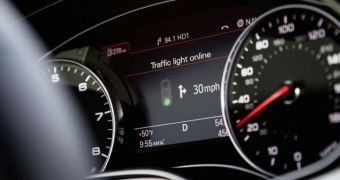German automobile manufacturer Audi claims to have come up with a very innovative method to improve on the ecological footprint of cars driven up and down roads worldwide.
This solution to reducing traffic-related emissions is a so-called traffic light recognition technology which the car manufacturer claims can reduce a vehicle's carbon dioxide emissions by about 15%.
Besides, Audi estimates that, should this technology be embraced by Germany's current fleet, some 900 million liters of fuel would be kept from being wasted.
Business Green tells us that the Audi Online system makes it possible to establish a link between a given car and the traffic light network of a certain region.
This is achieved by means of an in-car Internet connection, the German car manufacturer explains.
With the help of this technology, drivers have access to information such as the speed that they need to be at in order to pass through lights on their route without having to stop.
Should drivers already find themselves waiting at a red light, the systems lets them know exactly how much longer they have to wait for the next green light to appear.
Besides, the system can interact with a car's Star-Stop function, and thus ensure that the engine is switched on five seconds before the light turns green and the driver can continue their journey.
Audi explains that its traffic light recognition technology it intended to reduce both fuel consumption and traffic-related emissions by cutting down on the amount of time that cars more often than not spend idling at lights.
The automotive manufacturer says that this innovative system, which was first demonstrated at the Consumer Electronics Show in January in Las Vegas, is currently undergoing trial runs in several cities across the world.
More precisely, connections with as many as 50 sets of traffic lights are now being trialed in the city of Las Vegas in the United States.
Similar tests are ongoing in Verona, Italy, where 60 sets of lights are being used, and in Berlin, Germany, where 25 Audi drivers can link their vehicles to about 1,000 traffic lights spread across this urban area.
Interestingly enough, media reports say that, although this technology is still being tested, the German car manufacturer expects that it will not be long until it can officially make it available to its customers.
Thus, in a press release issued this past March 10, the company maintains that a “a market launch is currently the subject of intense analysis in the United States.”

 14 DAY TRIAL //
14 DAY TRIAL //